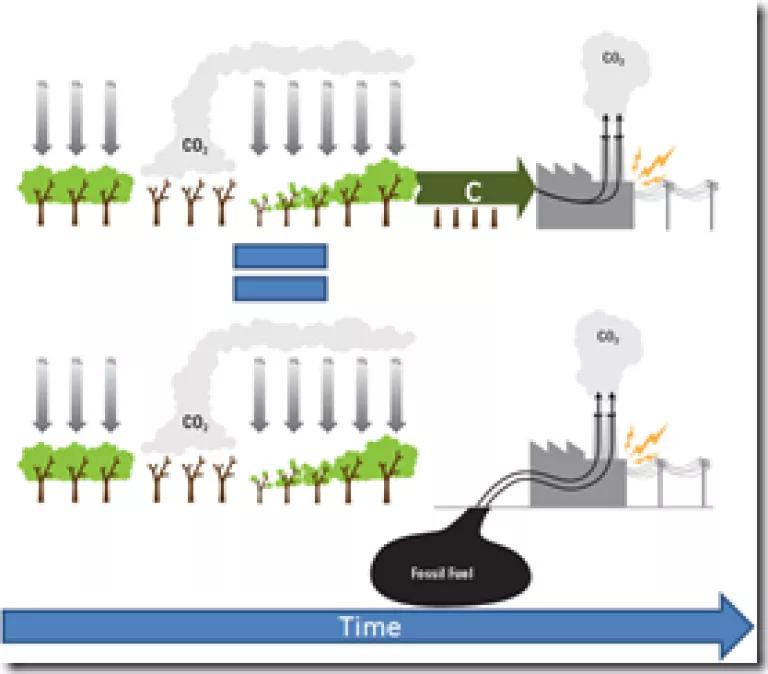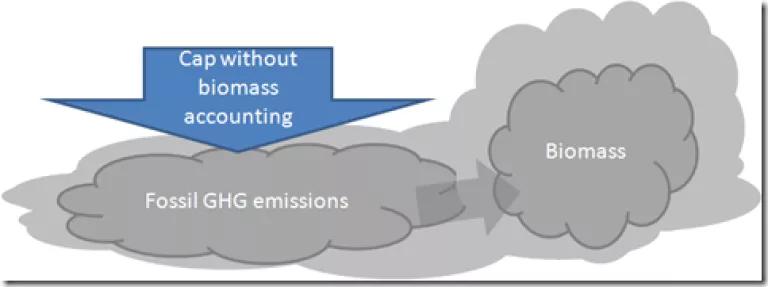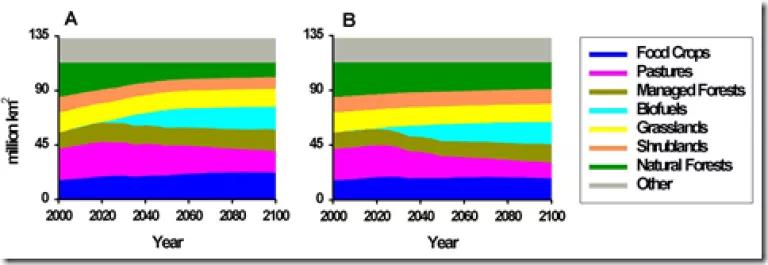
Last Monday, I posted a video about a critical accounting error that threatens to turn climate legislation into a big incentive for deforestation. Here’s a narrative version of the same description. If you’ve seen the video this should sound and look familiar.
Let’s start just thinking about a basic bioenergy plant—it could be turning corn into ethanol, but let’s imagine one turning trees into electricity. The carbon in those trees ends up in the atmosphere as CO2.
The problem is that the climate bill passed by the House and the one being debated by the Senate Environment and Public Works Committee assumes that as long as those trees are “renewable biomass” then we can just ignore those emissions. Renewable biomass is a term used in the RFS to preclude the most destructive sources of biomass from being used to make biofuels. It’s about avoiding habitat and ecosystem destruction and really has little to do with carbon accounting. Furthermore, the final deals in the House basically expanded the renewable biomass definition to include everything. So essentially the House climate bill ignores all emissions from biomass.
But if we compare the carbon flows from our hypothetical biopower plant, we can see that they are essentially the same as those from a coal plant (or an oil refinery if we were imagining an ethanol plant. In both cases, carbon that wasn’t in the atmosphere yesterday is ending up there today to make our energy.

To justify this incorrect accounting, many look to the past absorption of carbon by the trees to justify the carbon neutral claims. But if we add the past absorption into the picture, we can see that that doesn’t really change anything. Still carbon that wasn’t in the atmosphere yesterday (because it was in the trees) is ending up there today to make our energy.

For bioenergy to be better than fossil fuels, we have to a) be honest and account for this initial release of carbon and b) look to the future. If we simply regrow our forest (or crop) maintaining the carbon balance on the land, we can start to amortize this initial release over more and more bioenergy. But we have to keep a number of things in mind. For instance, even mature forests still absorb carbon, so we need to account for the fact that the forest or field would have been absorbing carbon anyway. Also, forests take a long time to grow back. So between foregone sequestration and slow growth, carbon neutrality would take decades and maybe centuries to achieve—much longer than scientists tell us we have if we’re going to preserve life as we know it.
Furthermore, if the forest or field used to provide the biomass burned was being used before for other purposes, we have to recognize that the prior demand for food or fiber doesn’t simply disappear. Especially in the face of population growth and rising incomes around the world, we need to understand where that demand goes and what are the emissions impacts of displacing that demand. This is the infamous indirect land-use change issue.
There’s lots of nuts and bolts in understanding these absorption and releases on the land over time, but two things should be obvious to us all: 1) biopower might be good or bad for climate, but the assumption of neutrality is almost always going to be wrong; and 2) greenhouse gas emissions cause global warming whether they come from fossil fuels or biofuels, but we can’t reduce emissions that we won’t admit are happening.
To understand why this so important, think of a balloon. If the balloon represents all of our greenhouse gas emissions, we want our climate policies to push down on the balloon and reduce our pollution. But if our policies only push down on part of the balloon, industry has a strong incentive to simply shift the emissions from the regulated fossil fuel emissions to the unregulated bioenergy emissions. That part of the balloon swells up, our climate keeps warming, and we lose all our forests and grasslands while we’re at it.

Another less publicized article in Science recently looked at this balloon effect and came to the conclusion that exempting emissions from bioenergy will have major impacts on forests around the world. Interestingly, this analysis finds bioenergy playing a big role under both scenario (A) that ignores biomass emissions and scenario (B) that includes these emissions. The difference is the type of land used to grow biomass—pastures verse forests.

The ideal approach would be to simply account for the emissions from burning biomass at the smokestack or tailpipe just like any other emissions, and credit or debit sequestration or emissions at the landscape level. Unfortunately, the science of accounting of emissions and sequestration on the land is not as solid as accounting for emissions at smokestacks and tailpipes. As a result putting land under the cap at this point would weaken the certainty of the cap. (This is why it’s so important that EPA play a lead role in overseeing agricultural carbon offsets, but that’s a different blog.)
Instead, we recommend directing EPA working with USDA and DOE to figure out a way to assign different emissions factors to different sources of biomass based on how the land is being managed and the expected net GHG balance.
Unfortunately, some in the biofuels industry have responded to the idea that a climate bill intended to reduce our carbon emissions should at least try to count those emissions accurately with all too predictable pleas that they be exempted (subscription required). Earlier in October, a group of biofuel industry organizations issued a statement complaining about potential “double regulation.” Beyond the climate bill, the other regulation in question? The Renewable Fuel Standard, a huge government mandate for 15 billion gallons of corn ethanol, 16 billion gallons of cellulosic biofuels, and 5 billion gallons of other advanced biofuels. As long as these biofuels are being produced, oil companies have to buy them regardless of cost. Now I have no love-loss for the oil companies, but this amounts to a huge subsidy to the biofuels industry, and in return for this government largess the qualifying fuels are supposed to provide real GHG benefits. This doesn’t seem too much to ask, but if the RFS is such a burden on the biofuels industry that it can’t comply with a climate law, there can only be one conclusion: let’s end the RFS.
However, we need low-carbon fuels and electricity, and if we do it right biofuels and biopower can play an important part in helping to stop global warming. But we can’t get biofuels right if we don’t start counting them right.

